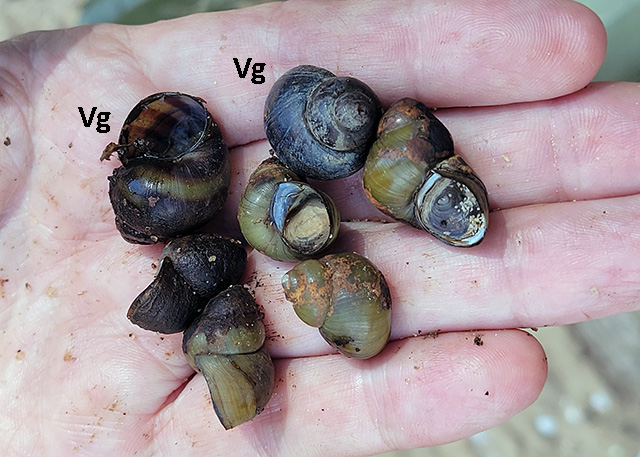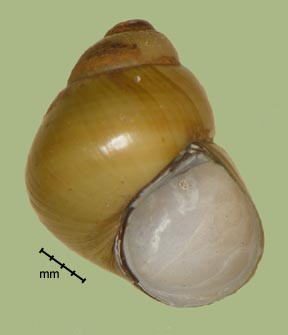> Habitat & Distribution
Clench & Fuller (1965) reported an entirely interior range for V. subpurpureus, spanning the Mississippi river system and several smaller Gulf drainages. The FWGNA database includes quite a few records in the lower Ohio and Wabash Rivers, becoming less frequent above their junction. We have two records from impoundments of the Tennessee River: Kentucky Lake in the west and Chicamauga Lake in the East.
The species was not known to be invasive until the appearance of large volumes of dead shell on the shoreline of Lake Marion in 2003, mixed with V. georgianus. Its spectacular increase in population density may be related to a burst of macrophyte production, triggered in turn by a prolonged drought. Subsequent programs of aquatic weed control seem to have resulted in population crashes for both invasive viviparids. See my essay of 29Oct03, available from the link below for more. FWGNA incidence rank I-4.
> Ecology & Life History
At our most recent visit to the lakes, we observed V. subpurpureus populations at moderate densities on sandy bottoms in shallow water, apparently engaged in a mixture of grazing and filter-feeding. Reproduction is apparently semelparous in Louisiana populations, some populations reaching maturity in but a single year, others requiring two years (Brown & Richardson 1992).
> Taxonomy & Systematics
The taxonomy of American Viviparus has been stable since the brief monograph of Clench & Fuller (1965). Although V. subpurpureus bears a shell broadly similar in size and form to that of the better known V. georgianus, the two are distinguishable by the rounded shoulders and color bands generally prominent on the latter.
> Maps and Supplementary Resources
- PDF map of Viviparus distribution in Atlantic drainages (2013)
- Viviparus distribution in the drainage of The Ohio (2019)
- Viviparus distribution in the Tennessee/Cumberland (2022)
- Two V.
georgianus and six V.
subpurpureus in Lake Marion, SC.

> Essays
- I posted an essay on Invasive Viviparids in South Carolina to the FWGNA blog on 29Oct03. Several additional photos were included.
- I reviewed all the Viviparus records in the USGS Nonindigenous Aquatic Species database while researching my post of 16Oct15, "To Only Know Invasives." I didn't find any well-documented populations here in The East previously unknown to me.
- I reviewed A Gene Tree for the Worldwide Viviparidae published by Stelbrink et al. (2020) in my post of 9Mar21. The focus of that essay was on Cipangopaludina and V. georgianus, but V. subpurpureus received brief attention as well.
> References
Brown, K.M. & Richardson,
T. D. (1992)
Phenotypic plasticity in the life histories and production of two
warm-temperature viviparid prosobranchs. Veliger 35:
1-11.
Brown, K. M., Varza,
D.& Richardson, T. D. (1989)
Life histories and population dynamics of two subtropical snails
(Prosobranchia:Viviparidae). J. N. Am. Benthol. Soc. 8:
222-228.
Clench, W. (1962)
A
catalogue of the Viviparidae of North America with notes on the
distribution of Viviparus georgianus, Lea. Occas. Pprs. on Mollusks,
Mus. Comp. Zool. Harvard, 2, 261-87.
Clench, W. &
Fuller, S. (1965) The genus Viviparus in North
America. Occas. Pprs. on Mollusks, Mus. Comp. Zool. Harvard, 2, 385-412.
Minton, R.L. and L.L.
Wang (2011)
Evidence of sexual shape dimorphism in Viviparus (Gastropoda:
Viviparidae). Journal of Molluscan Studies
77(3):315-317.
Richardson, T.D.
& Brown, K.M. (1989) Secondary
production of two subtropical snails
(Prosobranchia:Viviparidae). J. N. Am. Benthol. Soc. 8:
229-236.
Stelbrink,
B., R. Richter, F. K hler, F. Riedel, E. Strong, B. Van Bocxlaer, C.
Albrecht, T. Hauffe, T. Page, D. Aldridge, A. Bogan, L-N. Du, M.
Manuel-Santos, R. Marwoto, A Shirokaya, and T. Von Rintelen (2020)
Global diversification dynamics since the Jurassic: Low dispersal and
habitat-dependent evolution explain hotspots of diversity and shell
disparity in river snails (Viviparidae). Systematic Biology
69:
944 961.








